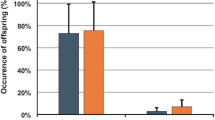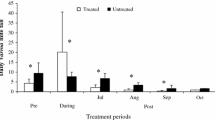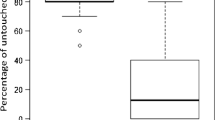Abstract
Varroa destructor is one of the most important sanitary threats for the beekeeping industry and so far disease control is based mainly on chemical treatment. However, a long-term solution may arise from studying natural surviving colonies of Apis mellifera. We compared the Varroa infestation rate in six commercial colonies that received annual treatment against mites and six non-treated colonies that survived in absence of any treatment for the last 6 years. In addition, we evaluated two potential mechanisms that might be involved in colony survival: hygienic (HYG) and Varroa-sensitive hygiene behavior (VSH) by means of pin-killed and mite artificial infestation, respectively. HYG and VSH were negatively correlated with mite infestation independently of the colony group (treated or non-treated). Furthermore, colonies expressing high levels of pupae removal (≥ 80%) showed higher %HYG and lower mite infestation compared to colonies showing low pupae removal (< 80%). The analysis of reproductive status of mites from the non-removed infested cells evidenced that more infertile mites are found in colonies with more than 80% of pupae removal. To study non-treated colonies that survive for several years, it is a suitable approach for identifying the underlying mechanisms related to Varroa-resistance.

Similar content being viewed by others
Data availability
The datasets generated during the current study are available from the corresponding author on reasonable request.
Code availability
Not applicable.
References
Agra MN, Conte CA, Corva PM, Cladera JL, Lanzavecchia SB, Palacio MA (2018) Molecular characterization of Apis mellifera colonies from Argentina: genotypic admixture associated with ecoclimatic regions and apicultural activities. Entomol Exp Appl 166:724–738. https://doi.org/10.1111/eea.12719
Allen M, Ball B (1996) The incidence and world distribution of honey bee viruses. Bee World 77(3):141–162. https://doi.org/10.1080/0005772X.1996.11099306
Antúnez K, Invernizzi C, Mendoza Y, van Engelsdorp D, Zunino P (2017) Honeybee colony losses in Uruguay during 2013–2014. Apidologie 48:364–370. https://doi.org/10.1007/s13592-016-0482-2
Aumeier P, Rosenkranz P, Gonçalves LS (2000) A comparison of the hygienic response of Africanized and European (Apis mellifera carnica) honey bees to Varroa-infested brood in tropical Brazil. Genet Mol Biol 23(4):787–791. https://doi.org/10.1590/S1415-47572000000400013
Baruffi L, Damián G, Guglielmino C, Malacrida A, Gasperi G (1995) Polymorphism within and between population of Ceratitis capitata. Comparison between RAPD and multilocus enzyme electrophoresis data. Heredity 74(4):425–437. https://doi.org/10.1038/hdy.1995.60
Beaurepaire AL, Krieger KJ, Moritz RFA (2017) Seasonal cycle of inbreeding and recombination of the parasitic mite Varroa destructor in honeybee colonies and its implications for the selection of acaricide resistance. Infect Genet Evol 50:49–54. https://doi.org/10.1016/j.meegid.2017.02.011
Boecking O, Drescher W (1992) The removal response of Apis mellifera L. colonies to brood in wax and plastic cells after artificial and natural infestation with Varroa jacobsoni Oud. and to freeze-killed brood. Exp Appl Acarol 16:321–329. https://doi.org/10.1007/BF01218574
Blettler DC, Fagundez GA, Caviglia OP (2017) Contribution of honeybees to soybean yield. Apidologie 49:101–111. https://doi.org/10.1007/s13592-017-0532-4
Boecking O, Genersch E (2008) Varroosis–the ongoing crisis in bee keeping. J Verbrauch Lebensm 3(2):221–228. https://doi.org/10.1007/s00003-008-0331-y
Boot WJ, Calis JNM, Beetsma J, Hai DM, Lan NK, Van Toan T, Trung LQ, Minh NH (1999) Natural selection of Varroa jacobsoni explains the different reproductive strategies in colonies of Apis cerana and Apis mellifera. Exp Appl Acarol 23:133–144. https://doi.org/10.1023/A:1006050527004
Buchler R, Kovacic M, Buchegger M, Puškadija Z, Hoppe A, Brascamp EW (2020) Evaluation of traits for the selection of Apis mellifera for resistance against Varroa destructor. Insects 11:618. https://doi.org/10.3390/insects11090618
Calderone NW (2012) Insect pollinated crops, insect pollinators and US agriculture: trend analysis of aggregate data for the period 1992–2009. PLoS ONE 7(5):e37235. https://doi.org/10.1371/journal.pone.0037235
Cheruiyot SK, Lattorf MG, Gath RK, Mbugi JP, Muli E (2018) Varroa-specific hygienic behavior of Apis mellifera scutellata in Kenya. Apidologie 49:439–449. https://doi.org/10.1007/s13592-018-0570-6
Colin T, Forster CC, Westacott J, Wu X, Meikle WG, Barron AB (2021) Effects of late miticide treatments on foraging and colony productivity of European honey bees (Apis mellifera). Apidologie 52:474–492. https://doi.org/10.1007/s13592-020-00837-3
Dainat B, Dietemann V, Imdorf A, Charrière JD (2020) A scientific note on the ‘Liebefeld method’ to estimate honeybee colony strength: its history, use, and translation. Apidologie 51:422–427. https://doi.org/10.1007/s13592-019-00728-2
Danka RG, Harris JW, Villa JD, Dodds GE (2013) Varying congruence of hygienic responses to Varroa destructor and freeze-killed brood among different types of honeybees. Apidologie 44:447–457. https://doi.org/10.1007/s13592-013-0195-8
Danka RG, Harris JW, Dodds GE (2016) Selection of VSH-derived “Pol-line” honey bees and evaluation of their Varroa-resistance characteristics. Apidologie 47:483–490. https://doi.org/10.1007/s13592-015-0413-7
DeGuzman LI, Rinderer TE, Frake AM (2008) Comparative reproduction of Varroa destructor in different types of Russian and Italian honey bee combs Exp. Appl Acarol 44:227–238. https://doi.org/10.1007/s10493-008-9142-1
Dietemann V, Nazzi F, Martin SJ, Anderson DL, Locke B, Delaplane KS, Wauquiez Q, Tannahill C, Frey E, Ziegelmann B, Rosenkranz P, Ellis J (2013) Standard methods for Varroa research. J Apicult Res 52(1):1–54. https://doi.org/10.3896/IBRA.1.52.1.09
Ellis JD, Evans JD, Pettis J (2010) Colony losses, managed colony population decline, and colony collapse disorder in the United States. J Apicult Res 44:134–136. https://doi.org/10.3896/IBRA.1.49.1.30
Eynard SE, Sann C, Basso B, Guirao AL, Le Conte Y, Servin B, Tison L, Vignal A, Mondet F (2020) Descriptive analysis of the Varroa non-reproduction trait in honey bee colonies and association with other traits related to Varroa resistance. Insects 11(8):492. https://doi.org/10.3390/insects11080492
Gray A, Adjlane N, Arab A, Ballis A, Brusbardis V et al (2020) Honey bee colony winter loss rates for 35 countries participating in the COLOSS survey for winter 2018–2019, and the effects of a new queen on the risk of colony winter loss. J Apic Res 59(5):744–751. https://doi.org/10.1080/00218839.2020.1797272
Giacobino A, Molineri AI, Pacini AC, Fondevila N, Pietronave H et al (2016) Varroa destructor and viruses association in honey bee colonies under different climatic conditions. Environ Microbiol Rep 8(3):407–412. https://doi.org/10.1111/1758-2229.12410
Guzmán-Novoa E, Eccles L, Calvete Y, Mcgowan J, Kelly PG, Correa-Benítez A (2010) Varroa destructor is the main culprit for the death and reduced populations of overwintered honey bee (Apis mellifera) colonies in Ontario, Canada. Apidologie 41:443–450. https://doi.org/10.1051/apido/2009076
Harbo JR, Harris JW (2005) Suppressed mite reproduction explained by the behaviour of adult bees. J Apicult Res 44(1):21–23. https://doi.org/10.1080/00218839.2005.11101141
Harris JW (2007) Bees with Varroa sensitive hygiene preferentially remove mite infested pupae aged less than five days post capping. J Apicul Res 46:134–139. https://doi.org/10.1080/00218839.2007.11101383
Harris JW, Danka RG, Villa JD (2012) Changes in infestation, cell cap condition, and reproductive status of Varroa destructor (Mesostigmata: Varroidae) in brood exposed to honey bees with Varroa sensitive hygiene. Annls Entomol Soc Am 105:512–518. https://doi.org/10.1603/AN11188
Häußermann CK, Giacobino A, Munz R, Ziegelmann B, Palacio MA, Rosenkranz P (2019) Reproductive parameters of female Varroa destructor and the impact of mating in worker brood of Apis mellifera. Apidologie 51:342–355. https://doi.org/10.1007/s13592-019-00713-9
Ibrahim A, Spivak M (2006) The relationship between hygienic behavior and suppression of mite reproduction as honey bee (Apis mellifera) mechanisms of resistance to Varroa destructor. Apidologie 37(1):31–40. https://doi.org/10.1051/apido:2005052
Ibrahim A, Reuter GS, Spivak M (2007) Field trial of honey bee colonies bred for mechanisms of resistance against Varroa destructor. Apidologie 38:67–76. https://doi.org/10.1051/apido:2006065
Invernizzi C, Zefferino I, Santos E, Sánchez L, Mendoza Y (2015) Multilevel assessment of grooming behavior against Varroa destructor in Italian and Africanized honey bees. J Apicult Res 54(4):321–327. https://doi.org/10.1080/00218839.2016.1159055
Klein AM, Vaissière BE, Cane J, Steffan-Dewenter I, Cunningham SA, Kremen C, Tscharntke T (2007) Importance of pollinators in changing landscapes for world crops Proc. R Soc B 27:303–313. https://doi.org/10.1098/rspb.2006.3721
Kulhanek K, Steinhauer N, Rennich K, Caron DM, Sagili RR, Pettis JS, Ellis JD, Wilson ME, Wilkes JT, Tarpy DR, Rose R, Lee K, Rangel J, vanEngelsdorp D (2017) A national survey of managed honey bee 2015–2016 annual colony losses in the USA. J Apicult Res 56(4):328–340. https://doi.org/10.1080/00218839.2017.1344496
Le Conte Y, Mondet F (2017) Natural selection of honeybees against Varroa destructor. in Beekeeping–from science to practice, eds R.H. Vreeland and D. Sammataro (Cham: Springer): 189–194. https://doi.org/10.1007/978-3-319-60637-8_12
Le Conte Y, Ellis M, Ritter W (2010) Varroa mites and honey bee health: can Varroa explain part of the colony losses? Apidologie 41(3):353–363. https://doi.org/10.1051/apido/2010017
Le Conte Y, Meixner MD, Brandt A, Carreck NL, Costa C, Mondet F, Büchler R (2020) Geographical distribution and selection of European honey bees resistant to Varroa destructor. Insects 11:873. https://doi.org/10.3390/insects11120873
Liendo MC, Muntaabski I, Russo RM, Lanzavecchia SB, Segura DF, Palacio MA, Cladera JL, Fernández PC, Scannapieco AC (2021) Temporal changes in volatile profiles of Varroa destructor-infested brood may trigger hygienic behavior in Apis mellifera. Entomol Exp Appl 169:563–574. https://doi.org/10.1111/eea.13048
Locke B (2016) Natural Varroa mite-surviving Apis mellifera honey bee population. Apidologie 47:467–482. https://doi.org/10.1007/s13592-015-0412-8
Locke B, Fries I (2011) Characteristics of honey bee colonies (Apis mellifera) in Sweden surviving Varroa destructor infestation. Apidologie 42:533–542. https://doi.org/10.1007/s13592-011-0029-5
Locke B, Le Conte Y, Crauser D, Fries I (2012) Host adaptations reduce the reproductive success of Varroa destructor in two distinct European honey bee populations. Ecol Evol 2(6):1144–1150. https://doi.org/10.1002/ece3.248
Locke B, Forsgren E, de Miranda JR (2014) Increased tolerance and resistance to virus infections: a possible factor in the survival of Varroa destructor-resistant honey bees (Apis mellifera). PLoS ONE 9(6):e99998. https://doi.org/10.1371/journal.pone.0099998
Lodesani M, Colombo M, Spreafico M (1995) Ineffectiveness of Apistan treatment against the mite Varroa jacobsoni Oud. in several districts of Lombardy (Italy). Apidologie 26(1):67–72. https://doi.org/10.1051/apido:19950109
Lodesani M, Pellacani A, Bergomi S, Carpana E, Rabitti T, Lasagni P (1992) Residue determination for some products used against Varroa infestation in bees. Apidologie 23(3):257–272. https://doi.org/10.1051/apido:19920309
Maggi M, Antúnez K, Invernizzi C, Aldea P, Vargas M, Negri P, Brasesco C, De Jong D, Message D, Weinstein Texeira E, Principal J, Barrios C, Ruffinengo S, Rodríguez Da Silva S, Eguaras M (2016) Honeybee health in South America. Apidologie 47:835–854. https://doi.org/10.1007/s13592-016-0445-7
Martel AC, Zeggane S (2002) Determination of acaricides in honey by high-performance liquid chromatography with photodiode array detection. J Chromatogr A 954(1):173–180. https://doi.org/10.1016/S0021-9673(02)00126-7
Martin SJ (1998) A population model for the ectoparasitic mite Varroa jacobsoni in honey bee (Apis mellifera) colonies. Ecol Modell 109:267–281. https://doi.org/10.1016/S0304-3800(98)00059-3
Martin SJ (2001) Varroa destructor reproduction during the winter in Apis mellifera colonies in UK. Exp Appl Acarol 25:321–325. https://doi.org/10.1023/A:1017943824777
Martin SJ (2004) Acaricide (pyrethroid) resistance in Varroa destructor. Bee World 85(4):67–69. https://doi.org/10.1080/0005772X.2004.11099632
Martin SJ, Ball BV, Carreck NL (2010) Prevalence and persistence of deformed wing virus (DWV) in untreated or acaricide-treated Varroa destructor infested honey bee (Apis mellifera) colonies. J Apicult Res 49(1):72–79. https://doi.org/10.3896/IBRA.1.49.1.10
Martin SJ, Hawkins GP, Brettell LE, Reece N, Correia-Oliveira ME, Allsopp MH (2020) Varroa destructor reproduction and cell re-capping in mite-resistant Apis mellifera populations. Apidologie 51:369–381. https://doi.org/10.1007/s13592-019-00721-9
Medici S, Maggi M, Sarlo E, Ruffinengo S, Marioli J, Eguaras M (2015) Presence of synthetic acaricides in beeswax and its relationship with the development of resistance in Varroa destructor. J Apic Res 53(3):267–274. https://doi.org/10.1080/00218839.2016.1145407
Merke J (2016) Doctoral thesis: “Dinámica poblacional de Varroa destructor y Apis mellifera L. como herramienta para la selección de abejas tolerantes”. Facultad de Ciencias Exactas y Naturales. Universidad Nacional de Mar del Plata.
Mordecai G, Brettell L, Martin S et al (2016) Superinfection exclusion and the long-term survival of honey bees in Varroa-infested colonies. ISME J 10:1182–1191. https://doi.org/10.1038/ismej.2015.186
Mondet F, Beaurepaire A, McAfee A, Locke B, Alaux C, Blanchard S, Danka B, Le Conte Y (2020a) Honey bee survival mechanisms against the parasite Varroa destructor: a systematic review of phenotypic and genomic research efforts. Int J Parasitol 50(6–7):433–447. https://doi.org/10.1016/j.ijpara.2020.03.005
Mondet F, Parejo M, Meixner MD, Costa C, Kryger P et al (2020b) Evaluation of suppressed mite reproduction (SMR) reveals potential for Varroa Resistance in European honey bees (Apis mellifera L.). Insects 11(9):595. https://doi.org/10.3390/insects11090595
Moro A, Blacquière T, Panziera D, Dietemann V, Neumann P (2021) Host-parasite co-evolution in real-time: changes in honey bee resistance mechanisms and mite reproductive strategies. Insects 12(2):120. https://doi.org/10.3390/insects12020120
Neumann P, Carreck NL (2010) Honey bee colony losses. J Apicult Res Research 49:1–6. https://doi.org/10.3896/IBRA.1.49.1.01
Oddie M, Buchler R, Dahle B, Kovacic M, Le Conte Y, Locke B, de Miranda JR, Mondet F, Neumann P (2018) Rapid parallel evolution overcomes global honey bee parasite. Sci Rep 8:7704. https://doi.org/10.1038/s41598-018-26001-7
Palacio MA, Figini E, Ruffinengo SR, Rodriguez EM, Del Hoyo ML, Bedascarrasbure EL (2000) Changes in a population of Apis mellifera L. selected for hygienic behavior and its relation to brood disease tolerance. Apidologie 31(4):471–478. https://doi.org/10.1051/apido:2000139
Palacio MA, Rodriguez E, Goncalvez L, Bedascarrasbure EL, Spivak M (2010) Hygienic behaviors of honey bees in response to brood experimentally pin-killed or infected with Ascosphaera apis. Apidologie 41:602–612. https://doi.org/10.1051/apido/2010022
Panziera D, van Langevelde F, Blacquière T (2017) Varroa sensitive hygiene contributes to naturally selected Varroa resistance in honey bees. J Apicul Res 56(5):635–642. https://doi.org/10.1080/00218839.2017.1351860
Pereira RA, Morais MM, Francoy TM, Gonçalves LS (2013) Hygienic behavior of Africanized honey bees Apis mellifera directed towards brood in old and new combs during diurnal and nocturnal periods. Insects 4:521–532. https://doi.org/10.3390/insects4040521
Potts SG, Biesmeijer JC, Kremen C, Neumann P, Schweiger OE, Kunin WE (2010) Global pollinator declines: trends, impacts and drivers. Trends Ecol Evol 25(6):345–353. https://doi.org/10.1016/j.tree.2010.01.007
Requier F, Antúnez A, Morales CL, Aldea Sánchez P, Castilhos D, Garrido PM, Giacobino A, Reynaldi FJ, Rosso Londoño JM, Santos E, Garibaldi LA (2018) Trends in beekeeping and honey bee colony losses in Latin America. J Apicult Res 57(5):657–662. https://doi.org/10.1080/00218839.2018.1494919
Rinderer T, Harris JW, Hunt GJ, de Guzman LI (2010) Breeding for resistance to Varroa destructor in North America. Apidologie 41(3):409–424. https://doi.org/10.1051/apido/2010015
Rosenkranz P (1999) Honey bee (Apis mellifera L.) tolerance to Varroa jacobsoni Oud. in South America. Apidologie 30(2 3):159–172. https://doi.org/10.1051/apido:19990206
Rosenkranz P, Aumeier P, Ziegelmann B (2010) Biology and control of Varroa destructor. J Invertebr Pathol 103:S96–S119. https://doi.org/10.1016/j.jip.2009.07.016
Russo RM, Liendo MC, Landi L, Pietronave H, Merke J, Fain H, Muntaabski I, Palacio MA, Rodríguez G, Lanzavecchia SB, Scannapieco AC (2020) Grooming behavior in naturally Varroa-resistant Apis mellifera colonies from north-central Argentina. Front. Ecol. Evo https://doi.org/10.3389/fevo.2020.590281.
Sammataro D, Untalan P, Guerrero F, Finley J (2005) The resistance of Varroa mites (Acari: Varroidae) to acaricides and the presence of esterase. Int J Acarol 31(1):67–74. https://doi.org/10.1080/01647950508684419
Schöning C, Gisder S, Geiselhardt S, Kretschmann I, Bienefeld K, Hilker M, Genersch E (2012) Evidence for damage-dependent hygienic behaviour towards Varroa destructor parasitised brood in the western honey bee, Apis mellifera. J Experim Biol 215:264–271. https://doi.org/10.1242/jeb.062562
Spivak M (1996) Honey bee hygienic behavior and defense against Varroa jacobsoni. Apidologie 27(4):245–260. https://doi.org/10.1051/apido:19960407
Spivak M, Reuter GS (1998) Performance of hygienic honey bee colonies in a commercial apiary. Apidologie 29:291–302. https://doi.org/10.1051/apido:19980308
Spivak M, Reuter GS, Lee K, Ranum B (2009) The future of the MN hygienic stock of bees is in good hands! Am. Bee J 149:965–967
Sumpter DJT, Martin SJ (2004) The dynamics of virus epidemics in Varroa-infested honey bee colonies. J Anim Ecol 73:51–63. https://doi.org/10.1111/j.1365-2656.2004.00776.x
Strauss U, Dietemann V, Human H, Crewe RM, Pirk CWW (2016) Resistance rather than tolerance explains survival of savannah honeybees (Apis mellifera scutellata) to infestation by the parasitic mite Varroa destructor. Parasitology 143:374–387. https://doi.org/10.1017/S0031182015001754
Tentcheva D, Gauthier L, Zappulla N, Dainat B, Cousserans F, Colin ME, Bergoin M (2004) Prevalence and seasonal variations of six bee viruses in Apis mellifera L. and Varroa destructor mite populations in France. Appl. environm microbiol 70(12):7185–7191. https://doi.org/10.1128/AEM.70.12.7185-7191.2004
Thaduri S, Stephan JG, de Miranda JR et al (2019) Disentangling host-parasite-pathogen interactions in a varroaresistant honeybee population reveals virus tolerance as an independent, naturally adapted survival mechanism. Sci Rep 9:6221. https://doi.org/10.1038/s41598-019-42741-6
Toufailia HMA, Amiri E, Scandian L, Kryger P, Ratnieks FL (2014) Towards integrated control of Varroa: effect of variation in hygienic behaviour among honey bee colonies on mite population increase and deformed wing virus incidence. J Apicult Res 53(5):555–562. https://doi.org/10.3896/IBRA.1.53.5.10
van Alphen JJM, Fernhout J (2020) Natural selection, selective breeding, and the evolution of resistance of honeybees (Apismellifera) against Varroa. Zoological Lett 6(6):6. https://doi.org/10.1186/s40851-020-00158-4
Vandame R, Palacio MA (2010) Preserved honey bee health in Latin America: a fragile equilibrium due to low-intensity agriculture and beekeeping? Apidologie 41:243–255. https://doi.org/10.1051/apido/2010025
Vandame R, Morand S, Colin ME, Belzunces LP (2002) Parasitism in the social bee Apis mellifera: quantifying costs and benefits of behavioral resistance to Varroa destructor mites. Apidologie 33:433–445. https://doi.org/10.1051/apido:2002025
Acknowledgements
Camila Miotti and Adriana Pacini are doctoral and post-doctoral fellows, respectively; Agostina Giacobino, Ana Molineri, Alejandra Scannapieco and Marcelo L. Signorini are Research Career Members from the Consejo Nacional de Investigaciones Científicas y Técnicas (CONICET, Argentina).
Author information
Authors and Affiliations
Contributions
MV, JM, and AG conceived the study; MV, EO, MC, and NB prepared and evaluated colonies at field level. AP and AS evaluated colonies at laboratory level. BB performed haplotype analysis. CM, AM, and MS performed the statistical analysis. AG wrote the manuscript draft, which was revised and had its final version approved by all coauthors.
Corresponding author
Ethics declarations
Ethics approval
Not applicable.
Consent to participate
Not applicable.
Consent for publication
Not applicable.
Conflict of interest
The authors declare no competing interests.
Additional information
Section Editor: David Bruce Conn
Publisher's note
Springer Nature remains neutral with regard to jurisdictional claims in published maps and institutional affiliations.
Rights and permissions
About this article
Cite this article
Visintini, M., Pacini, A., Merke, J. et al. Field evaluation of Varroa-resistance traits in surviving Apis mellifera colonies in Argentina. Parasitol Res 120, 4013–4021 (2021). https://doi.org/10.1007/s00436-021-07337-y
Received:
Accepted:
Published:
Issue Date:
DOI: https://doi.org/10.1007/s00436-021-07337-y




